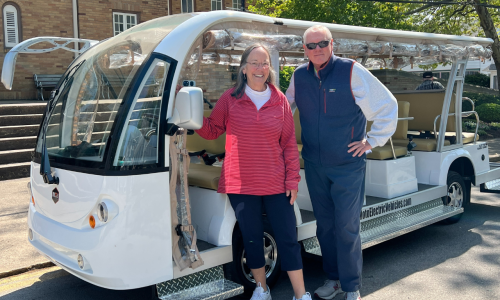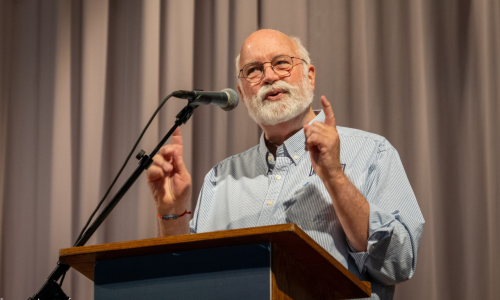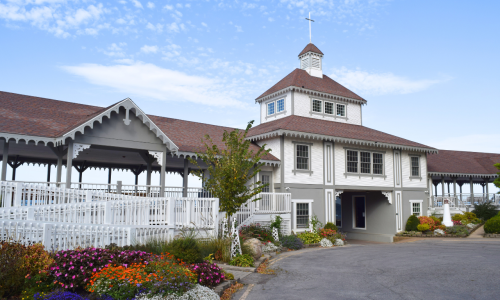By Grant Lefeler, Devlopment Intern
Near the corner of West Fourth Street and Walnut Avenue, a preserved piece of machinery sits in the shadow of Hoover Auditorium. Surrounded by a black metal cage and shielded from the sun by a wooden roof, the brightly-colored apparatus of turn-of-the-20th century farming equipment greets guests who stream into Hoover’s Walnut Avenue adjacent entrances.
Its placement on the western side of the auditorium is no mistake; its position serves as a considerable reminder to Lakesiders of the role the Hoover family, and particularly their potato diggers, played in the growth and development of Lakeside. Due to the Hoover family’s generosity, Lakeside emerged not only as a permanent fixture in the Chautauqua Movement but as a functioning, goal-oriented community.
In the late 19th century and early 20th century, Chautauquas were established and built to provide four guiding pillars to the American masses: Religion, Education, Arts, and Recreation. As Lakeside continued to grow in the years following the Great War, it became painfully clear to the community, and especially then-General Manager A.L. Hoover, that to fulfill Lakeside’s commitment to those pillars, a new auditorium had to be constructed. Seeking a large structure where speakers, performers, and preachers could showcase their voices to a mass audience, plans for a new auditorium were formalized in 1928.
However, Lakeside was not spared by the sudden economic crisis faced by Americans with the start of the Great Depression in 1929, nearly putting a cap on the construction of the new auditorium. Thankfully, Hoover would not be deterred by Lakeside’s declining fortunes. Utilizing his own financial resources, with thanks to his family’s fortune from the invention and selling of potato diggers, a “temporary” auditorium was constructed.
Over 93 years and thousands of audience members, entertainers, speakers, and preachers later, that “temporary” structure still stands today as Lakeside’s premier gathering place. While originally constructed to be an interim space that would allow Lakeside to bring three of the four pillars: Religion, Education, and Arts, to general audiences, the building once-known as Central Auditorium has evolved greatly since the Great Depression.
Rechristened as Hoover Auditorium in 1945 in memory of A.L.Hoover’s generous contributions to keeping Lakeside afloat during those troubling years, the structure became a space for speakers like Amelia Earhart, preachers in the form of Dr. Norman Vincent Peale, and traditional church choirs. In recent years, acts such as 1970s classic rock staple Three Dog Night and contemporary Christian singer Amy Grant have graced Hoover’s stage.
Despite Hoover’s enduring place in the hearts of performers and the guests who have come from far and wide to see them, time and technology has not been kind toward Hoover Auditorium. While built under the acceptable conditions for speaking halls in the early 20th century, the auditorium has fallen behind modern-day technical standards for music and speaking facilities.
Lakeside’s Director of Arts & Entertainment Shirley Stary, who is in her 18th year at Lakeside, understands the need for updates at the auditorium, stating, “In order to meet the needs for Lakeside’s 150th Anniversary and beyond, it is crucial that renovations are made to Hoover.”
To keep Hoover current, new LED lights must be installed on stage, the current doors must be replaced, and a climate control system alongside more backstage space must be added to not only keep both audience members and performers comfortable, but to preserve the auditorium’s equipment.
It is Lakeside’s hope that just as Hoover has provided families with programs that inspire and entertain for 93 years, it will do the same for 93 more.




